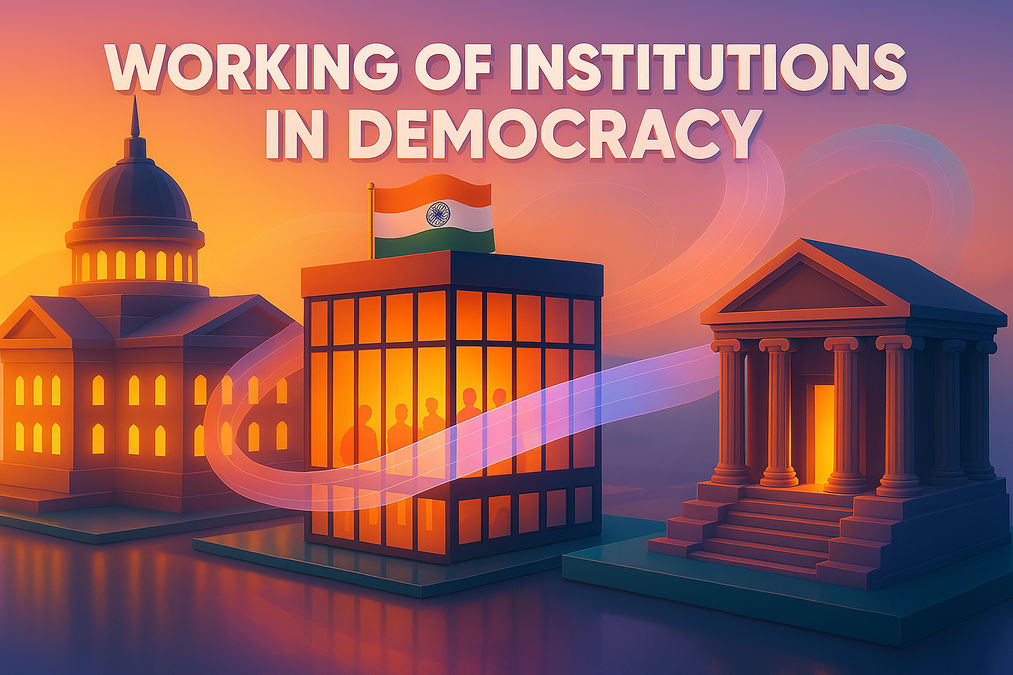Working of Institutions in Democracy: In-Depth Guide

Working of Institutions in Democracy: In-Depth Guide
Introduction
In any democracy, the working of institutions—the legislature, executive, and judiciary—defines how power is shared, laws are made, and rights are protected. This guide offers a super SEO-friendly, mobile-responsive overview, enriched with tables, examples, and FAQs for higher ranking and better user engagement.
Overview of Democratic Institutions
| Institution | Composition | Functions | Checks & Balances |
|---|---|---|---|
| Legislature | Bicameral: Lok Sabha & Rajya Sabha |
|
Presidential Assent; Judicial Review |
| Executive | Prime Minister & Council of Ministers; Civil Services |
|
Parliamentary Confidence; Legislative Scrutiny |
| Judiciary | Supreme Court, High Courts, Subordinate Courts |
|
Appointment Safeguards; Constitutional Limits |
1. Legislature: The Law-Making Body
The legislature enacts laws, approves budgets, and holds the executive accountable. Key aspects include:
1.1 Composition & Roles
Lok Sabha members are directly elected for five years; Rajya Sabha members serve six-year staggered terms.
1.2 Law-Making Process
- Bill Introduction
- Committee Review
- Three Readings & Debates
- Presidential Assent & Publication
Note: Money Bills originate in Lok Sabha; Rajya Sabha can only suggest amendments within 14 days.
2. Executive: Policy to Practice
The executive transforms legislation into action.
2.1 Political vs Permanent Executive
Political executive (PM & Ministers) sets policies; permanent executive (bureaucrats) implements them.
2.2 Policy Cycle
Steps: Agenda Setting → Policy Formulation → Implementation → Evaluation & Feedback.
Example: Swachh Bharat Mission showcases cross-ministry coordination.
3. Judiciary: Guardian of the Constitution
The judiciary ensures laws and actions conform to the Constitution.
3.1 Judicial Review & Basic Structure
Court power to invalidate laws/actions that violate fundamental rights or basic structure doctrine.
3.2 Public Interest Litigation (PIL)
PILs expand access to justice for marginalized groups.
4. Checks & Balances
- Legislature: Can remove executive via no-confidence.
- Executive: Can advise President on ordinances.
- Judiciary: Reviews both legislative and executive acts.
5. Conclusion
Robust democratic institutions, clear separation of powers, and mutual checks ensure responsive governance. Understanding these systems of democracy empowers informed citizenship and civic participation.
Frequently Asked Questions
Q1: What is the main function of the legislature?
To draft, debate, and pass laws; control public finances; and oversee the executive.
Q2: How does judicial review work?
Courts can strike down laws/actions that conflict with the Constitution’s provisions.
Q3: What is a money bill?
A bill exclusively dealing with taxation or government spending, originating in Lok Sabha.
Q4: What are PILs?
Litigations filed by citizens or groups to protect public interest or enforce rights.
Q5: How can the executive be held accountable?
Through parliamentary questions, debates, and no-confidence motions in Lok Sabha.
Join the conversation